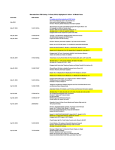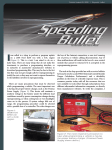Download February 2011 1 www.mastertechmag.com
Transcript
www.mastertechmag.com February 2011 1 *Details available at your authorized BMW center. 2 Master Technician Online www.mastertechmag.com Original BMW Parts www.bmwusa.com www.mastertechmag.com The Ultimate Driving Machine® February 2011 3 Contents Feature Stories 06 Switching It Up by John Anello No power window switches on a 2003 Pontiac Bonneville SSEI 14A Sprinter at the Start by Kerry Jonsson While a tall, fuel-efficient delivery truck answers many commercial needs, it also presents some new challenges for us in diesel diagnostics and repair. 28Cascading Diagnostics by John Anello The Jeep’s erratic running pointed to the PCM, but what other work had been done recently? Cover Story 22This Seat is Occupied by Kerry Jonsson In the quest for ever-increasing safety, seat occupancy detection systems help by giving the electronics the info needed to determine how to fire the airbags. That system is malfunctioning in this 2005 Chrysler Town & Country. It’s our job to diagnose and repair what’s wrong. 4 Master Technician Online www.mastertechmag.com Christopher M. Ayers, Jr. President/Publisher: [email protected] Bob Freudenberger Editor: [email protected] John Anello • Steve Campbell • Paul Cortes Kerry Jonsson • Phil Fournier • Chip Keen Greg McGoniga • Tony Molla • Tom Nash Henry Olsen • Matt Ragsdale • Dave Russ Contributing Editors: [email protected] Christopher-Michael Ayers Art Director, Project Mgr.: [email protected] Joann Turner Circulation Manager: [email protected] Editorial, Circulation, Advertising Sales and Business Office: Master Technician Magazine 486 Pinecrest Rd. • Springfield, PA • 19064 P.484.472.8441 • F.484.472.7460 Master Technician is published by Master Technician, LLC. The publisher and editors of this magazine accept no responsibility for statements made herein by advertisers or for the opinions expressed by authors of bylined articles or contributed text. The current Issue of the Master Technician Emag is free to qualified automotive repair shop owners, managers & technicians. Contact [email protected] for more information. All other content is available on a subscription basis. Visit www.mastertechmag.com for subscription information. If you have a letter to the editor, a Tech Tip or a story idea, Email: [email protected], or visit: www.mastertechmag.com/other/contact_us. Advertiser Index February 2011 AIRSEPT.. ................. 25 AutoTechOnWheels....5 BMW..........................2 BASF......................... 37 DAYCO..................... 19 Garage Operator....... 29 www.mastertechmag.com Henry Rifles.. ..............9 MasterTechnician..... 40 Mercedes-Benz.. ........ 21 NUCAP.. ................... 33 VISION.. ................... 11 Find John at the 2011 VISION Training Expo! February 2011 5 Switching It Up No power window switches on a 2003 Pontiac Bonneville SSEI I by John Anello, “The Auto Tech on Wheels” was called in to a shop for a complaint of no power window operation on a 2003 Pontiac Bonneville SSEI (Figure 1). They had already checked the power and ground feeds at the driver door master switch and everything seemed okay. The odd thing was that the other door windows would not operate from their individual switches. It was just hard to believe that this vehicle could have four bad window switches. The window motors all worked okay when power and ground were applied to each motor individually. The garage was uncertain where to turn, so rather than throwing parts at this car they decided to Figure 1: 2003 Pontiac call me in for a second opinion. Bonneville SSEI. 6 Master Technician Online www.mastertechmag.com When I arrived at the shop I verified the complaint by trying each power window switch and nothing responded. I next decided to print out a wiring diagram to familiarize myself with the system layout and see if I could find something in common that would affect power window operation at all four doors, such as a main power or ground feed. As I viewed the diagram, I found out that these were not your everyday “how you doin’” window switches. Instead, they were all separate door control modules. Each module in turn controlled window motor operation through an internal window motor driver. Operating the window switch only created a high/ low signal to command the window up or down. The switch no longer had to transmit a power or ground feed to the window motor directly, which made for less wear and tear on the switch contacts. separate low-current battery feeds, so here too nothing seemed common to all four door modules. Looking a little closer at the diagram, I could see that all four modules did share the same high-current feed from a 30 Amp circuit breaker, so this was the first place I wanted to look. I used my test light and checked each door module for high-current battery feed, and they all seemed to be okay. The tech said that all the wiring checked okay, and it did, but I still had to see for myself because you just never know. There have been many times when techs have used a logic probe to do a power and ground check without finding anything, yet a bad ground or power feed turned out to be the culprit. They relied on the logic probe’s ability to light a green or red LED as a valid check, which only required about 20 mA to light up, but when the ground or power had to step up to the plate to handle a a high-current circuit it would lose it’s connection. This is where a standard test light, which can load a circuit up to 300 mA, would be a better choice. Keep in mind, though, that this type of test light cannot be used on computer circuits because it can harm them. I used my Paintbrush function in Mitchell to color-code the wiring diagram. I chose green for the grounds, purple for the high-current circuit breaker feed, orange and red for lowcurrent battery feed (Figure 2). The ground feeds for each door module were at different locations, so it was hard to believe that the system had four open I discovered that the driver door module grounds. The rear door modules shared had the ability to communicate with a scan the same low-current battery feeds, but tool by looking at a data communication the front door modules had two other wiring diagram (Figure 3), which showed www.mastertechmag.com February 2011 7 S w itching It Up all the onboard controllers on the II scan tool to see if there were any trouble serial data network linked to the ALDL codes stored in memory that could lead connector. So, I hooked up my GM Tech me in the right direction. Looking at Figure 2: Wiring diagram, color coded: Green = Ground; Purple = Highcurrent Circuit Breaker Feed; Orange & Red = Low-current Battery Feed. 8 Master Technician Online www.mastertechmag.com “Henry rifles will only be made in America or they won’t be made at all.” Anthony Imperato President of Henr y Repeating Arms Henr y .22 Lever Frontier Model with Octagonal Barrel. An affordable, beautiful rifle with superior tack-driving accuracy. Crafted by American workers for American shooting enthusiasts. Henr y Golden Boy .22 LR /.22 Mag / .17HMR Henr y Big Boy .44 Magnum / 45C / .357 Mag Henr y Acu-Bolt .22 LR / .22 Mag / .17 HMR Henr y U.S. Sur vival .22 LR It’s not a prideful boast. It’s a solemn oath from all of us at Henry Repeating Arms. Every Henry rifle is and always will be made in America by American workers. Decent, hard working folks like you who take great pride in their work. We won’t follow the path of other manufacturers who have their products made overseas and slap their name on them. When you read the rollmark on the barrel of a Henry, it’s going to read Made in the USA. We start with only the finest ingredients - gun barrel quality steel from Ohio, genuine American walnut from Missouri and Iowa, steel castings from Wisconsin and brass components from Pennsylvania. We manufacture a rifle that you will be proud to own – with the smoothest action, flawless reliability, and pinpoint accuracy. Made in America with the same integrity as the Henry rifle President Lincoln owned. We are a family owned business and we stand behind every rifle that leaves our plant. You will find our customer service second to none, and we’ll do whatever it takes to guarantee your complete satisfaction. We invite you to become part of the Henry family. Please order our free catalog, which includes information about our rifles, a list of dealers in your area and a free Henry decal. For a FREE color catalog visit www.henryrepeating.com or call Toll Free (866) 200-2354 www.mastertechmag.com February 2011 9 S w itching It Up Figure 3: Data communication wiring diagram showing all the onboard controllers on the serial data network linked to the ALDL connector. 10 Master Technician Online www.mastertechmag.com the scan tool, I pulled some “U” codes of interest (Figure 4). The codes U1161, U1162 and U1163 all pertained to the driver’s door module’s inability to talk to the other three door modules. There was no access for my scan tool to talk to the other three modules because it was only able to access the mainstream controllers all on one network as seen in the communication link diagram. The door modules had their own private UART network that was shared among them, as can be seen by the blue coloredcoded lines in the Power Window Circuit diagram (Figure2). This seemed like a possible culprit if there was damage to this private network. According to the diagram, there was a splice for this private UART network located under the rug about 14cm from the left power seat breakout. I had the shop remove the front driver’s seat, and as I lifted the rug I noticed a lot of rust build-up on the floor from a prior water leak (Figure 5). I next located a conduit that held the splice internally wrapped with black electrical tape (Figure 6). I slowly removed the tape and was surprised to see a Scotch Lock Figure 4: “U” codes. www.mastertechmag.com February 2011 11 S w itching It Up connector joining all four UART lines going to the door modules (Figure 7). This connector was badly corroded and was barely making a connection for all the wires to share. I removed all of the wires and repaired the splice. Suddenly, all the windows were working fine. Figure 5: Lifting the rug, noticing a lot of rust build-up on the floor from a prior water leak. Figure 6: Located a conduit that held the splice internally wrapped with black electrical tape. Figure 7: Removing the tape, a Scotch Lock connector joined all four UART lines going to the door modules. 12 Master Technician Online So, now the recap on this whole scenario. I discovered that the door modules were on a private network with each other and even though they had their own power and ground feeds and switch signals, they all refused to operate when they were unable to communicate with one another. It was a default built into the system. What was amazing to me was why any manufacturer would use a Scotch Lock to connect these wires inside a harness running along a floorboard. Wouldn’t it have been better to use a solder joint located in a higher area not so susceptible to water damage? But, then again, who am I to secondguess the engineers? There’s always the possibility that this was a field repair done by another shop. I hope this story has enlightened you to better understand how a network, whether large or small, needs to be in proper order, or things may not work the way they were intended to. Just doing a simple power or ground check at a component does not always validate system integrity. Parts replacers beware! www.mastertechmag.com EXPO MECHANICAL COLLISION MANAGEMENT POWER SUMMIT TECHNICAL KEYNOTES COMEDY NIGHT NETWORKING SPOUSE PROGRAM Expanded in 2011! Over 85 technical and management courses during the 4-day event. Collision Industry Day and Collision Expo Thursday, March 3, 2011 Don’t miss out on this unique and energizing day designed for collision professionals. · · March 3-6, 2011 KANSAS CITY EVENT for Automotive Service Professionals www.mastertechmag.com The · · March 3-6, 2011 Collision Industry Day & Expo: March 3 Conference: March 4-6 Expo: March 4-5 Networking breakfast Select from multiple breakout sessions on a variety of hot topics and industry issues Lunch with keynote speaker Collision-specific expo featuring vendors with the latest products and services Check the website for the latest schedule and course offerings! “I have gone from the east coast to the west the coast, from the windy city to the sunshine state. Dollar for dollar, ASA MoKan puts on the best training show in the country.” Gary Walsh, Technician Hughes Motor Corp, Yonkers, NY presented by VISION’S P OWER SUMMI T MARCH 4 , 2011 • KANSAS CITY Friday, March 4, 2011 Designed for shop owners and managers, this premier training day is dedicated to bringing together some of the industry’s most knowledgeable, most influential and most thoughtful people to delve into many important topics, issues and trends that are impacting the independent service marketplace. SUCCESS LEADERSHIP POWER PANEL ENERGIZE PROFITS OPPORTUNITIES NETWORKING “I have attended the VISION event many times. The training is the best of the best. Everyone in the automotive business should be there.” Terry Steenholdt, AAM T.D.S. Auto Repair, Sioux Falls, SD February 2011 13 t a r e t n i r p t AS r a t S the While a tall, fuel-efficient delivery truck answers many commercial needs, it also presents some new challenges for us in diesel diagnostics and repair. W hen you first noticed one on the road, you probably thought, “What an unusual looking vehicle.” And the first service problem you ran into was likely when your customer needed brakes. “What, you want me to bring them down so you can match them up? Who ever heard of such a thing?” was a common customer response to your likely request. Eventually, parts suppliers learned the difference between Ate and Bosch, so that problem smoothed out. When it comes to diesel diagnosis and repair issues, however, things are not so easy. Given this winter’s cold weather, you’ve probably run into more than your fair share of “no-starts,” “hard starts,” and “extended cranks.” You probably have some experience with American 14 Master Technician Online by Kerry Jonsson The PCM won’t open the injectors unless it sees a signal from the crankshaft position sensor, which is mounted in the block on the driver’s side, by the bell-housing. You can check resistance, AC voltage, and scope the signal to verify that it’s working properly. www.mastertechmag.com diesels, such as Ford Powerstroke, Chevy DuraMax, and Dodge Cummins, and may feel pretty comfortable with them. While the same basic principles apply, you can reduce your diagnostic time if you know the particulars of the systems found on the Dodge Sprinter. Scan tool diagnostics used to be readily available to us, but now not so much. When dealing with no-starts, hardstarts, and extended cranks on pre-2004 Sprinters, you often have to go on a road call and/or tow them in. Or, some incautious person may have tried the dangerous practice of spraying starting fluid or carburetor cleaner into the intake to get the engine started. You’ve probably heard the appropriate cautions: Leave the key on to time out the glow plugs, and spray while cranking. You may do this every day, but it’s our duty to inform you that it’s foolhardy. Suppose, for example, that somebody else accidentally cycles the key -- kaboom! While we won’t go on record as recommending it, silicone spray is a much safer alternative. fuel system developed by Mercedes-Benz. Instead of the traditional pump timing high-pressure pulses to the injectors, this works more like gasoline EFI, albeit at much, much higher psi. The common rail is continuously supplied with ultra-high pressure, and the injectors are electrically triggered by means of electronic logic. So, there’s a computer in control of timing and pulse width. Obviously, that control unit needs to know when to fire the injectors, partially on the basis of signals from crankshaft and camshaft position sensors. This is the low-pressure fuel sensor. It’s mounted under the #1 and #2 intake runner. Since it’s a typical three-wire sensor, you can monitor the signal line. Key on, engine off, you should see .5V; cranking/running it should be just over one volt. Actually, nobody should have to add an explosive fuel source to get the engine started regardless of the weather. What engineer would allow a non-starter to be produced? You just have to figure out what the problem is. Glow plugs? Fuel delivery? Injection? These 2.7L vehicles use a direct-injection, common-rail diesel www.mastertechmag.com February 2011 15 A Sprinter at the Start The fuel injection control unit is mounted under the driver’s side of the dash, to the left of the brake pedal. The crank sensor resides on the driver’s side of the engine block toward the back by the transmission bell housing. The engine will not start at all without the crank sensor signal. This sensor is an AC pulse generator. Like most AC pickups, it uses a two-wire design. A good sensor will “ohm out” at about 900 ohms between pins #1 and #2 on the sensor. If you crank the engine at normal speed, you should see about one volt AC. If you’re scoping the signal, expect over 4 VAC peak-to-peak. A normal cranking rpm would be about 200 to 220. A weak battery will yield a lower cranking speed and AC voltage output, so check the The high-pressure sensor is mounted on the front of the fuel battery first. The engine will start without the cam position sensor signal, but you’ll have a MIL (Malfunction Indicator Lamp) and a code will set. If you have extended crank time, you still need to be concerned with fuel pressure and the glow plug system. There are two halves to fuel pressure: the low-pressure delivery system that draws fuel from the tank and supplies it to the next phase, and the high-pressure pump that is driven off of the camshaft. The high pressure goes to the fuel rail and distribution pipes that supply each injector. Excess fuel is collected in a 16 Master Technician Online rail. Measure the signal voltage on the center pin -- you should see .5V KOEO. During cranking, it should go to about 1.0V before the engine starts. manifold at the rear of the cylinder head, and returned through the fuel filter, and, finally, a cooling coil. The low-pressure system comprises a mechanically-driven pump that draws fuel from the tank through a filter. That is, unless there’s a blockage somewhere. A clogged fuel filter from additives and contaminants is a common problem. Additives intended to improve lubricity www.mastertechmag.com Sprinter injectors are of the direct variety. You can use a “’noid” light to see if they’re getting a pulsing signal while cranking, Another test is to remove the return line and crank -- fuel should pulse out of the top. Be careful of the pressure and fire hazard. can, over time, settle in the filter and restrict flow. Dodge recommends changing the filter every 30,000 miles, or once a year. The water-in-fuel sensor is mounted in the bottom of the filter up to the 2004 model year. It’s a threewire sensor with a 12V reference, 12V signal line, and ground. The signal line gets pulled towards ground when there’s water in the fuel. www.mastertechmag.com The purpose of the low-pressure system is to assure that the high-pressure system doesn’t run out of fuel when the engine is under heavy loads. Injection pressure may be as high as 30,000 psi (you read that right -- 2,000 BAR!), so a constant supply of fuel is definitely needed. A transparent nylon line feeds the high-pressure pump, so you should be able to see bubbles if there’s air in the system. You can check the low-pressure side by splicing a gauge into this feed line. You should see about 17 psi at idle, but it can go as high as 35 to 45 psi while driving. There’s also a three-wire low-pressure sensor. On the signal line, you should see .5V with no pressure, and about 2.5V at idle. It can go over 3.0V during acceleration. The high-pressure side uses a threepiston pump that runs at 1-1/3 the speed of the camshaft. Like those of all other modern “clean” diesels, it generates tremendous pressure, which is injected directly into the combustion chamber. Full pressure is needed to get the engine started, and volume is relatively low, so even small leaks will bleed off enough pressure to cause a no-start. Be very careful when inspecting the highpressure side for leaks -- wear safety glasses and gloves as there’s plenty of psi to penetrate your skin and give you a diesel tattoo. We’re not aware of any February 2011 17 A Sprinter at the Start gauge outside of engineering circles that can be tapped into the rail to measure this pressure, but it can be monitored by means of the high-pressure sensor mounted on the front of the fuel rail. This is a three-wire sensor with a 5V reference, signal line, and ground. You can see these voltages on your DRB III scan tool, but you’ll need the Sprinter Card, a MUX box adapter, and a special red-plug cable. The signal line will have .5V with no significant pressure in the system. While cranking, you should see the voltage rise to about 1.0V as the engine starts. If you do not reach about 875 psi the engine may not start. That’s about .875V at the signal wire. If you don’t see at least that much, look for external leaks in the high pressure lines. There may also be internal leaks. For example, a leaky injector may keep the pressure from building up sufficiently. There’s also a solenoid at the back of the high-pressure fuel rail that controls psi according to load. It’s called, logically enough, the Fuel Rail Pressure Control Solenoid, which the fuel injection control unit can close or open to raise or lower fuel pressure according to need. It has an “O” ring at its end. If that should break, it will create an internal leak that will not allow enough pressure to build to allow starting. You may have to physically remove the solenoid to make sure this is intact. If you suspect that an injector is leaking, you can unscrew each injector line one at a time and install a ball bearing to block flow. When you The upper trace is the low-pressure get to the leaking injector, high-side fuel sensor signal, and the lower trace is that of the high-pressure sensor. pressure will rise and the engine should The first step up in both patterns start the other four cylinders. If you can’t is the ignition key turned on. The find any internal or external leaks, you next step is cranking and running. may just have a high-pressure pump that The end of the lower pattern shows an increase in high pressure is not up to its task. from acceleration. 18 Master Technician Online www.mastertechmag.com www.mastertechmag.com February 2011 19 A Sprinter at the Start Dodge has a test for the high-pressure pump, assuming there are no leaks in the system. You start by unplugging the solenoid and checking fuel pressure while cranking. The engine will not start, but you should see about 800psi on your scan tool, or .8 volts on the highpressure sensor signal wire. Your DMM’s display rate may be too slow to give you an accurate reading, so you might want to use a graphing multi-meter, or a lab oscilloscope to watch the voltage. You should see a steady signal above .9V. You may see it spike over 1.0V, but then drop down. The drop indicates that the pump cannot maintain pressure, or has a weak piston. This pressure drop will keep the engine from starting, and you’ll have to replace the high-pressure pump. We’ve noticed that they may start to become questionable at between 90,000 and 100,000 miles. Of course, the glow plug system can cause a starting issue. On pre-2004 models, the glow plug controller is under the battery tray. It has three connections: a battery power cable, a six-pin connector with five wires (one for each glow plug), and a two-wire connector (one wire is ground, and the other is the signal from the fuel injection control unit for how long to energize the plugs). If you want to measure the resistance of the glow plugs, simply unplug the six-pin 20 Master Technician Online connector and check ohms between each pin on the connector and an engine or battery ground. You should see about 1 ohm. These are “pencil” type glow plugs, which heat up very quickly. The draw for each is about 20 amps. If you measure the current on all of them, you will normally see 75 to 100 amps depending on how cold the temperature is. The signal from the fuel injection control unit to the glow plug controller starts off at 10 to 11 volts with the key on and the engine off. A “wait-to-start” light will come on in the instrument cluster. The CTS (Coolant Temperature Sensor) signal is used to determine how long the glow plugs are energized. The signal will then change to an inconsistent square wave. This is normal as the glow plugs are still pulsed on the first few seconds the engine is running to help with combustion on a cold engine. You can unplug the CTS to get maximum glow plug time from the controller -- be aware that the electric cooling fan will come on as a fail-safe when you do this. Starting problems can be tricky, but the more you know about the systems involved the more efficient you’ll be at troubleshooting. Sprinters are typically fleet vehicles, so any downtime is costing your customers money. A fast and accurate diagnosis will keep them happy with you. What more could you want? www.mastertechmag.com FIRE... . . . on all eight with www.startekinfo.com. Mercedes-Benz USA Dealer Workshop Services is the source for all the technical information needed to support, service, and maintain Mercedes-Benz vehicles. Mercedes-Benz workshops rely on DWS products and services for getting jobs done quickly and more efficiently. Our products include: s STAR TekInfo with WIS-net (Workshop Information System) s Electrical Troubleshooting Manuals s Installation Instructions s Technical Bulletins s Campaigns s Mercedes-Benz Special Tools s s s s s s s Maintenance Manuals and Sheets STAR Service Manual Library CDs WIS and DAS software updates Star Diagnosis System (SDS) Operator’s Manuals and COMAND Manuals Mercedes-Benz Equipment Inventory of technical publications STAR TekInfo Dealer Workshop Services Engineering Services, Mercedes-Benz USA, LLC. www.mastertechmag.com February 2011 21 T h i s Seat is Occupied “This Seat Is Occupied” by Kerry Jonsson In the quest for ever-increasing safety, seat occupancy detection systems help by giving the electronics the info needed to determine how to fire the airbags. That system is malfunctioning in this 2005 Chrysler Town & Country. It’s our job to diagnose and repair what’s wrong. W e’ve all had to keep pace with rapidly-advancing technology, perhaps especially so with new developments in automotive safety. It seems that every year or so a new airbag gets added -driver’s side, passenger’s side, dual-stage, side, curtain airbag, knee bolster, etc. These measures have reduced fatalities and serious injuries, and their resultant medical costs. But they’ve also been known to kill. Small children and frail elderly people sometimes can’t survive the full force of a deploying airbag. For years, the only defense was to relegate such passengers to the back seat. Now, airbag technology has advanced to the point that 22 Master Technician Online occupant detection systems measure the weight of the passenger and determine if and how the airbags should be fired. The primary code led us to diagnose a bad seat belt tensioner, but the second code directed us to a relatively new item added in 2005, the Occupancy Classification Module. www.mastertechmag.com But what if something goes wrong? In the past, we’ve had to diagnose bad airbag squibs, crash sensors, and clocksprings, but a problem in the detection system was new to us. A 2005 Chrysler Town & Country came in with the airbag light on. While pulling codes, we realized that there are two different systems we can communicate with. On this Town & Country, Chrysler used an ORC (Occupant Restraint Controller -- a.k.a. Airbag Control Module), and an OCM (Occupancy Classification Module -- a.k.a. Occupant Sensor). In earlier years, the ORC controlled both driver’s and passenger’s side airbags solely on the basis of the seat belt buckle switch status. In 2005, the OCM got input from additional sensors that monitor the passenger’s side front seat. Since we had a warning light, our first step was to pull codes. We looked in the ORC and found two codes: Driver’s Seat Belt Tensioner Circuit Open, and OCM Active DTCs. On this particular model, the seat belt tensioner is on the buckle side of the belt assembly, not on the adjustable belt side. We then checked for codes in the OCM. Occupant Classification Undetermined Status, No ORC Messages and OCM Data Transfer Error came up. The ORC code for the driver’s side seat belt tensioner circuit was a straightforward diagnosis. www.mastertechmag.com Chrysler has a one-ohm resistor tool that you substitute for the tensioner or airbag circuit. You then clear the codes and see if they come back. If they do, you have a wiring or control unit problem. If they don’t, replace the seat belt tensioner. Of course, before doing any diagnostic or repair work you must disconnect the battery for at least two minutes to be safe. You can then unplug the airbags and tensioners and replace them with the one-ohm load simulator to test for codes. If you don’t have this special tool, you can also check resistance on individual wires between the ORC and, in our case, the driver’s side seat belt The OCM module is located under the front passenger seat cushion. It gets voltage from the Front Control Module, and relies on both a weight sensor and a seat belt tension sensor to determine how the passenger’s side airbags should be fired. February 2011 23 T h i s Seat is Occupied tensioner squib. Keep in mind that there are shorting bars in the ORC computer connector. When it’s unplugged the two wires for each squib are shorted together to prevent accidental firing. If you measure resistance between these wiring pairs you should see continuity, which is normal. This vehicle ended up needing the driver’s side seat belt buckle, but we had other fish to fry. Profe Pro Turne control the airbag warning light. What it does is monitor if someone is sitting in the passenger side seat and reports this information back to the ORC, which is in charge of deployment. These modules communicate through a single-wire PCI bus. We wanted to verify that this wire was not shorted to power or ground, or open. We checked resistance from pin #15 of the ORC and pin #8 of the OCM and measured just under ¼ of an ohm. TurD Prevent Preve The three codes found in the OCM still turned on the light. These codes all dealt By putting a lab scope on the with the passenger’s side airbag system, communication wire, we could see if the heart of which is the OCM module. there was communication, or if there This module doesn’t fire the airbags, or was interference from other voltage ProBle ProBlem Lubricant d Lubricant drains dow a/c compre a/c compressor’s mo soluTio soluTion Rotate the Rotate theTool, compress before Tool, before attachin feaTure feaTures>> Fits all >> Uses a >> Fits all compress By watching the oscilloscope pattern of the PCI bus we could easily >> Won’t s Uses a standard determine that there was communication among control units.>>The bus links many modules, so it was possible that some other unit was >> Won’t slip, and al interfering with communications. That should have flagged some other communication code, however. 24 Master Technician Online www.mastertechmag.com essional ComPressor ofessional ComPressor er Tool™ New! rner Damage toLeaks New Compressors! FixTool™ Line ® ® ® ® Increase Your repaIr revenue & customer satIsfactIon In 5 Minutes ent Damage to New Compressors! Before PlaCing The Before PlaCing BelT on The The BelT on The ComPressor probLeM SoLution ComPressor Problem 4PMVUJPO use The Line SpLice - new Metricuse SizeS The coMpreSSor Guard ComPressor ComPressor Turner Tool™! Tool™! LineTurner Splice STOP! STOP! t %BNBHFE-JOFT t 1JOIPMF-FBLT Fix Leaks in 5 Minutes! t $SPTTUISFBEFE+PJOUT t 1SPWFO4FBMJOH5FDIOPMPHZ t /P-JOF3FNPWBM t 3FTJTUT5PSTJPOBM7JCSBUJPO >>click here for more information $POOFDUTMJOFTPGEJòFSFOUEJBNFUFS'JUT BOEMJOFT Fits in tight spaces em stoP CoMPressor CoMebaCks! >>click here for more information kits avaiLabLe For: patent(Crown pending Honda (Crv) trs090 & Hs110 Ford 10s20F victoria) patent pending 10Pa-17 (import) GM (r4 & H-series) Ford (Fs-10 & Fx-15) Chrysler (a590 & C171) TURNER TURNERTOOL! TOOL! Shown here larger than actual size www.airsept.com 800.999.1051 678.987.0500 drains down during warehouse storage leaving an wn during warehouse storage leaving an essor’s moving unprotected at initial startup. d440aparts r134a Leak detector oving parts unprotected at initial startup. ion FinD sMaLL reFriGerant Leaks Fast! J2791-CertiFieD >>click here for more information compressor 2 turns using the Compressor Turner 2 turns the using the Compressor Turner esor attaching drive belt to the compressor. ng the drive belt to the compressor. coMpreSSor turner tooL Prevent DaMaGe to new CoMPressors! ReCommeNDeD By ReCommeNDeD By ComPressor manufaCTurers ComPressor >>click here for more information manufaCTurers es l compressors with a threaded opening in the clutch hub including R, H, and V series compressors standard 19mm (3/4”) wrench sors with a threaded opening in the clutch hub including R, H, and V series compressors FaSteruse recycLe Guard slip, and allows of greater torque than a spanner wrench 19mm (3/4”) ProteCtwrench a/C serviCe MaCHines tranSGuard tranSMiSSion FiLter FroM seaLant & Debris ProteCt transMission rePairs FroM Debris llows use of greater torque than a spanner wrench >>click here for more information SKU Description Available 204042 In Stock COMPRESSOR TURNER TOOL www.mastertechmag.com February 2011 25 call 1-800-999-1051 or 678-987-0500 to order >>www.aIrsept.com SKU Description Available T h i s Seat is Occupied or ground sources. We did see a 7.1 to 7.5V square wave with the ignition key on. This meant the wires were not shorted and the control units could communicate with each other. If there was a communication problem between these two units, it could be because one of the units was malfunctioning, or some other control unit was putting out erroneous data and confusing the others. We decided to check codes in the other control units on the PCI bus, but didn’t find any that dealt with a loss of communication. So, we concluded that the communication problem was isolated between the ORC and the OCM units. We suspected the OCM module because the first code (Occupant Classification Undetermined Status) suggested that it may not be functioning properly. The second code (No ORC Messages) meant that the OCM could not communicate with the ORC even though we could see the communication on the PCI bus. The final nail in the OCM coffin was the last code -- OCM Data Transfer Error. We knew the communication wire was okay, so the OCM itself must have been causing the problem. We wanted to be sure that there were no other outside influences causing the OCM to not work properly. You should always check powers and grounds before replacing any control Looking at this weight sensor signal, we see about 4V volts with the ignition key on. The voltage dropped to about 1V with 185lbs in the seat. You can watch this signal voltage with a DMM as well. 26 Master Technician Online www.mastertechmag.com unit, but with newer CAN systems that OCM to fail, we decided to check the can be tricky. two other sensors that provide inputs to the OCM. This OCM is directly grounded through pin #5. The power supply is another The first is a weight sensor in the matter -- there’s no conventional fuse bottom of the passenger seat. It is a supplying ignition-on power to the unit. bladder type sensor with three wires for A Front Control Module, incorporated reference voltage, signal, and ground. into the Integrated Power Module, The reference is 5V and comes from pin supplies almost 11V to pin #9 of the #7. The signal comes in on pin #6 and OCM when the ignition key is turned changes with the weight applied to the on. Without this power-up signal, the seat. With no weight, you should see OCM may not communicate with the about 4V, and with a 185 lb. man in the other control units on the PCI bus. In seat the signal drops to just about 1V. our case, both the power-up signal and In other words, the greater the weight, ground passed our tests. To further see the lower the signal voltage. If you have if outside influences were causing the codes for this sensor, refer to TSB #08- The seat belt tension sensor is mounted in the lower mount of the belt, so moving the reel will not change the signal voltage. You can check the voltage and pull up on the belt. You should see the signal voltage change from about 1V to 4.3V while pulling. www.mastertechmag.com February 2011 27 T h i s Seat is Occupied 001-04 on passenger side airbag safety issues and aftermarket parts, such as an add-on cushion, that can interfere with proper sensor operation. The second is the Belt Tension Sensor. This component also uses a threewire design. The 5V reference comes from pin #16 of the OCM, and isn’t shared with that of the weight sensor. The ground is also separate and comes through pin #14. The belt tension signal comes in on pin #4. With no tension on the belt, you should see just under 1V on the signal line. Pulling the belt out of the B-pillar mount will not cause the signal to change. The sensor reads the tension on the mount side at the base of the B-pillar. Grab the belt near the base and pull up. You should see the signal rise to about 4.3V. Since the sensors were functioning properly, our repair was going to be the installation of a new OCM. It’s mounted on the underside of the passenger seat cushion, and is fairly easy to get to. Even though it’s a control unit, it doesn’t need to be programmed or coded when installed. However, it is not just plugand-play, either. You will have to calibrate the weight sensor after installing a new OCM. With your DRB III/Star Scan, or equivalent, you can calibrate the weight sensor, but you are going to have to throw some weight around. It is a threestage process. You start with an empty seat. You then put 37.5 lbs. on the seat. In the next step you add an additional 10.6 lbs., and, finally, 52.5 lbs. With a total of five codes in this Chrysler airbag system, we needed to make the customer aware of the hours of diagnostic time that would be needed to be accurate and precise with our conclusions. We must be bold enough to ask for an honest amount of diagnostic time so we don’t paint ourselves in a corner. During that time we need to perform all of the testing we can so we can make come to an educated conclusion. We know. With all the new systems springing up these days, that’s easier said than done. Share MasterTechnician with a friend! Get an extra 45 days, FREE Access, when you “Tell a Friend.”* *N ew registration subscribers must have valid Email. *Tell your Friend to enter “friend:(your user ID)” into the promocode section at sign up. *Promotion valid through June 2011 28 Master Technician Online www.mastertechmag.com A N e w I N d u s t ry s tA N dA r d IN s h o p M A N Ag e M e N t s o f t wA r e . EMPOWERMENT: Control your business Own the software and your data Connect & communicate with your PC based shop equipment Order parts electronically from vendors of YOUR choice Import labor times from ALLDATA and others Get the answers you need from GO’s unique reports BRAGGING RIGHTS: Regular updates & basic support for one low monthly fee. Continuous review and refinement from IATN, GO Users Forum. Selected as the exclusive shop management software for the AAIA Shop Of Tomorrow. See “Empowerment” above Visit www.garageoperator.com for more information. www.mastertechmag.com www.mastertechmag.com February 2011 29 Cascading Diagnosis by John Anello, “The Auto Tech on Wheels” The Jeep’s erratic running pointed to the PCM, but what other work had been done recently? I was called in to a shop for a complaint of erratic engine operation on a 2007 Jeep Grand Cherokee with a 5.7L engine (Figure #1). The engine would run fine with no problems for a while, but at any given moment it would begin to abruptly surge up and down and cut out. The engine could be immediately restarted and would run perfectly again until the next episode. The shop had installed high-performance spark plugs and ignition coils a few weeks earlier, but there were no drivability complaints at the time. The shop even put the old ignition coils back into the engine, but the problem still remained. There were no codes stored in the PCM memory, and the shop did not want to start playing Russian roulette with auto parts, so they called me in for tech assistance. to check for codes -- none were recorded in memory (Figure #2). I started the vehicle and it seemed to run okay, but then it suddenly started to run erratically with a bouncing tachometer. The engine seemed to dip in and out with a near-stall condition. After a few seconds of this, the engine just cut out as if the ignition key had been turned off. I immediately restarted the engine and the problem was gone. I ran it again for quite a while Figure 1: 2007 Jeep Grand Cherokee When I arrived, I attached my Escan generic OBD II scan tool to the vehicle 30 Master Technician Online www.mastertechmag.com and could not reproduce the problem. It was as if the crank or cam sensor was giving an erratic signal, or the PCM had an internal board issue. I could no longer reproduce the problem, so I offered the garage a free opinion: Try a new crank sensor due to their high failure rate. It would be a cheap fix if it worked. The shop called back the next day and told me that the crank sensor did not fix the problem and that they had rechecked all the PCM power and ground feeds. The shop was willing to try a new PCM since the problem was so intermittent and everything seemed to lead to an erratic computer. I agreed to program the new PCM for them in hopes that the problem would go away. I could not think of anything else that could cause such an erratic problem. I went there the next day after the new PCM was delivered to program it with new software and configure it to match the vehicle. I started the Jeep and it ran fine for the first 15 minutes, but then it went back into its dance. At this point I got that feeling we all get when we realize that there is an expensive unneeded part installed that someone has to take the blame for. At this point, the shop I were both now married to the vehicle, and we Figure 2: EScan shows no codes in memory www.mastertechmag.com February 2011 31 C a scading Diagnostics had to find the problem or this PCM was engine cut out. This had to be a loss of going to be this evening’s meal. power or ground to the PCM, or possibly a reference voltage feed momentarily I knew my timeframe was short for shorting to ground because the PCM finding the culprit because I had no idea was shutting down operations at the how long the problem was going to stick same time as it decided to no longer around. I quickly placed my Escan tool communicate with my scan tool. The on the vehicle and graphed some PCM only way I was going to nail this problem parameters to see if anything looked would be with a multi-trace scope to unusual or out of range (Figure #3). watch as many signals as I could before I was monitoring the rpm, MAP and this problem decided to go away. TPS sensors and could see the engine rpm going into an idle roll. But then I used my eight-trace Escope and something unusual happened -- I lost quickly selected six main items that communication with the PCM as the would help me pinpoint the problem problem got worse (Figure #4), then the using my different colored leads as Figure 3: Graphing data parameters 32 Master Technician Online www.mastertechmag.com NEW TECHNOLOGY FROM THE INDUSTRY LEADER IT’S QUICK, QUIET AND COOL. SNAPS IN PLACE AND HOLDS TIGHT. REDUCE NOISE + REDUCE HEAT = REDUCE COMEBACKS No brake job is truly complete without the NU-LOK Piston Cushion. NUCAP, the Brake Technology Company, has developed this revolutionary new product to create a barrier between the piston surface and brake pad. The NU-LOK Piston Cushion is a snap to use. It improves noise control while extending caliper life. Keep quiet, keep cool with the NU-LOK Piston Cushion – improve performance in everyday braking conditions and during extreme braking maneuvers. For A QUICK AND CoST EFFECTIVE SoLUTIoN To NoISY BrAKES orDEr NoW AT: www.PISTONCUSHION.COM Figure 4: Loss of scanner communication www.mastertechmag.com Noise PreveNtioN The hi-temp rubber coated NU-LOK Piston Cushion, based on floating design principles, is designed to absorb movement and minimize piston wear. It integrates with the existing brake pad shim to further reduce noise on any braking system. Heat DissiPatioN The NU-LOK Piston Cushion also acts as a heat shield between the pad/rotor and the caliper. This reduces brake fluid temperature for better pedal feel, more controlled stops and longer fluid life. The cushion also prevents caliper boots from overheating and possibly melting. February 2011 33 C a scading Diagnostics follows: white for PCM battery feed, blue for PCM ignition feed, red for PCM Auto Shutdown Down relay feed, purple for ASD relay coil driver, yellow for 5V reference, and green for PCM ground. As the engine started to run erratically, I captured my first event (Figure #5). I could see that the ASD relay driver momentarily was released by the PCM under 50ms, but I never lost my 5V reference, or my powers and grounds. It was as if something was telling the PCM to let go of the ASD relay coil, so I now had to dig a little deeper. I wanted to see if I was losing a cam or crank signal, so I captured two more events using my green lead for the cam signal (Figure #6) and my yellow lead for the crank signal (Figure #7). Neither waveform pattern showed a loss of cam or crank signal when the ASD relay was being released, but the tachometer was definitely following the cutting in and out of the engine. I had an eight-trace scope, so it was to my advantage to monitor all eight ignition coil primary circuits to see if any coil trigger was dropping out. I moved all my leads to the coil drivers and continued to monitor the engine’s operation. Today was my lucky day because this problem was only getting worse and it decided to Figure 4: Loss of scanner communication 34 Master Technician Online www.mastertechmag.com Figure 5 (Above): ECM releasing ASD relay coil Figure 6 (Below): Checking for loss of cam signal www.mastertechmag.com February 2011 35 C a scading Diagnostics I have done so far has lead me to erratic PCM operation and I just could not pinpoint the cause. I could see what the PCM was doing, but what was its reasoning? Bernie basically wanted me to go back to my scope and look below the zero line for any secondary voltage kickback that could cause a PCMreset condition. That’s when outside noises penetrate the PCM through electromagnetic interference and disrupt its normal algorithms, making it momentarily skip a beat. The engine in I decided to call Bernie Thompson no way or fashion had an engine misfire from Automotive Test Solutions just get due to a bad ignition coil or spark plug, his opinion on things because everything but it still seemed like a logical possibility. stick around and give me a joy ride. When I captured another event (Figure #8), I was surprised to see that I was losing all eight coil drivers at the same time. The PCM was letting go of the ASD relay coil and it did not start to trigger the ignition coils again until about 300ms later. There was something making this PCM halt all operations momentarily, or I possibly had a bad new PCM on hand. It would not be the first time I have come across a defective new part. Figure 7: Checking for loss of crank signal 36 Master Technician Online www.mastertechmag.com No matter what kind of car you’ve got in your paint shop, a perfect color match is always the goal. And that’s where BASF Refinish breaks from the field. Only BASF offers the COLOR-MAX®3 system, which covers every color category in the spectrum and only uses chips sprayed with authentic BASF Refinish paint—not printed with ink. So you are assured a precise match the first time, every time, reducing comebacks and increasing productivity. And remember, BASF Refinish coatings are already approved for use by most major OEMs in North America. For the kind of color matches that also match your customers’ expectations, call your local BASF distributor at 1-800-825-3000 or visit www.basfrefinish.com. www.mastertechmag.com FooseTM, Chip FooseTM, Foose DesignTM and the Chip Foose signature are registered trademarks of Foose Design Inc. and used with permission. February 2011 37 © 2009 BASF Corporation. C a scading Diagnostics I went back to my primary pattern and this time lifted it off the zero line to expose any activity below (Figure #9), and I was surprised to see multiple cylinders getting hit with secondary kickback voltage. Cars using PCMs that directly control coil primary may have a little secondary kick that may not have any effect on PCM operation, but if the kick does get great enough it could give the PCM a momentary heart attack and make it skip a beat, or, worse, do permanent damage to the PCM or an internal coil driver. in, but I was not so sure about the spark plugs. I had the shop pull a spark plug to get a look at what was currently installed in the engine. I then compared that spark plug to the original (Figure #10), and there was something funky about it. It had a triangle-shaped electrode for a special performance feature it offered. I had the shop remove all the spark plugs and put factory spec spark plugs back in. Once this was done, the problem was completely resolved. I can only tell you that I was taken aback by this turn of events. It is just so hard to I knew the original coils were put back believe that a company could manufacture Figure 8: Scoping all 8 coil drivers 38 Master Technician Online www.mastertechmag.com Figure 9: Secondary KV spikes present a spark plug for performance purposes without any regard to its effects in a coilover-plug environment. The problem it created mimicked a failed PCM that any tech would have automatically changed in the field. There were no codes, no sensor failures, or wiring issues. A multi-trace scope would have to be used to find a cascading effect of events that would point you in the right direction. I own many one-, two- and four-trace scopes, but with so many circuits involved with onboard control modules today, it sometimes makes more sense to use a bigger net to throw at a problem rather than fishing Figure 10: Comparing performance around with only a few hooks. spark plug www.mastertechmag.com February 2011 39 Repair and Business Solutions for Professional Automotive Technicians & Shop Owners mastertechmag www. .com Digital Magazines Hybrids & Everything “Green” Tool & Equipment Review Weekend Warrior : Fun Stuff Check out what’s coming in 2010 Register: For sixty days free access Volume 2 | Issue 1 Inside the Insider Small Business Relief The new Health Care Act will affect nearly every small business. The main provisions of the Act roll out over the next four years. page 1 Protect Your Company, and Limit Your Risks... There are strategies that a business may take in advance to maximaize the protection of its interests and limit its risks. page 1 The Three R’s keeping your current technician workforce productive and happy. It all begins with the 3R’s— Recruitment, Retention and Recognition. page 4 Forecast: Cloud Computing The who, what, where, when, and hows you need to know... Small Businesses May See Some Relief in the New Health Care Act Questions/Comments: Contact Us via Website or Call Chris Ayers Jr 484.472.8441 by Mary Louisa L’Hommedieu, Esq. The new Health Care Act will affect nearly every small business. The main provisions of the Act roll out over the next four years, with the major changes occurring in 2014. Most notably, beginning in 2014, businesses with more than 50 employees (or full-time equivalents) must provide affordable health insurance for their employees or face penalties. Businesses with fewer than 100 employees will be permitted to participate in insurance exchanges, to be set up in each state, where a pooling of resources should drive the costs of insurance down. And while small businesses are not required to offer insurance for their employees, the Act provides strong incentives for them to do so. Until the Small Business Health Options Programs or SHOP insurance exchanges become page 12 40 Master Technician Online www.mastertechmag.com www.mastertechmag.com | April 2010 1
























































